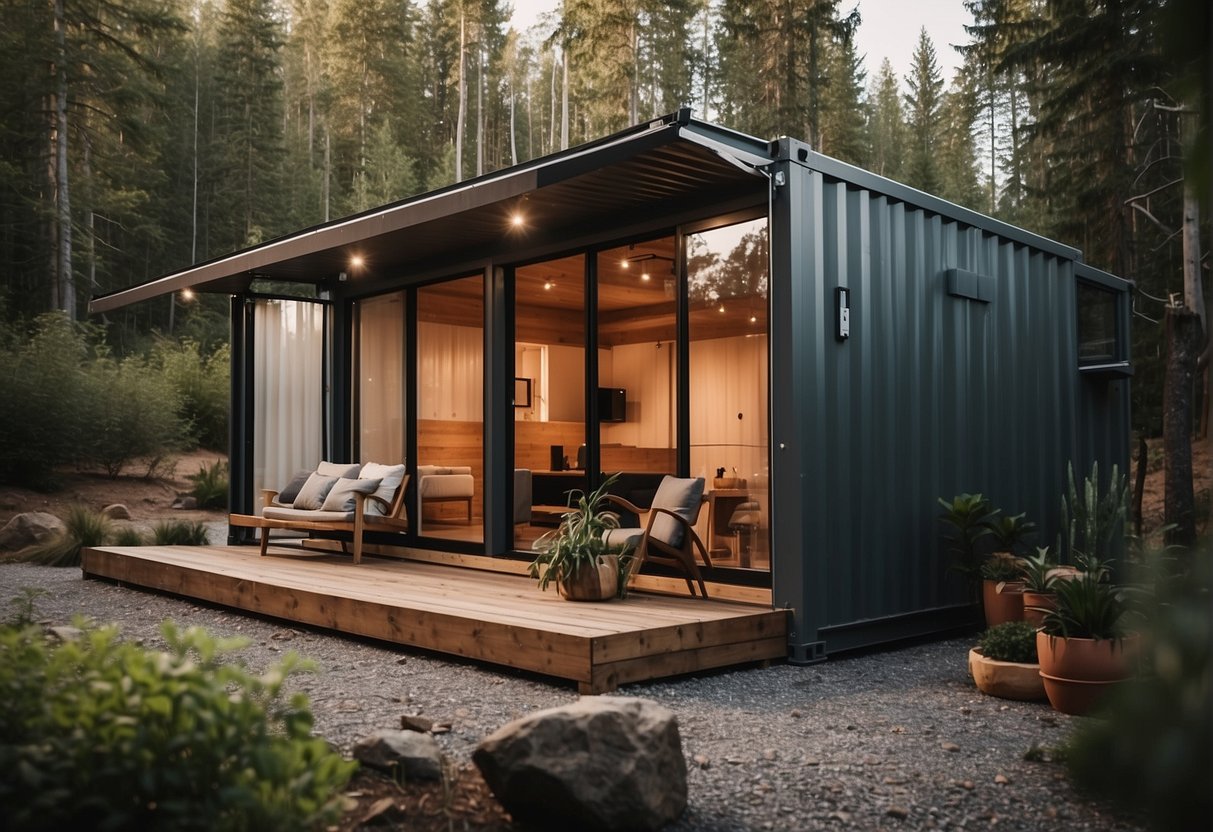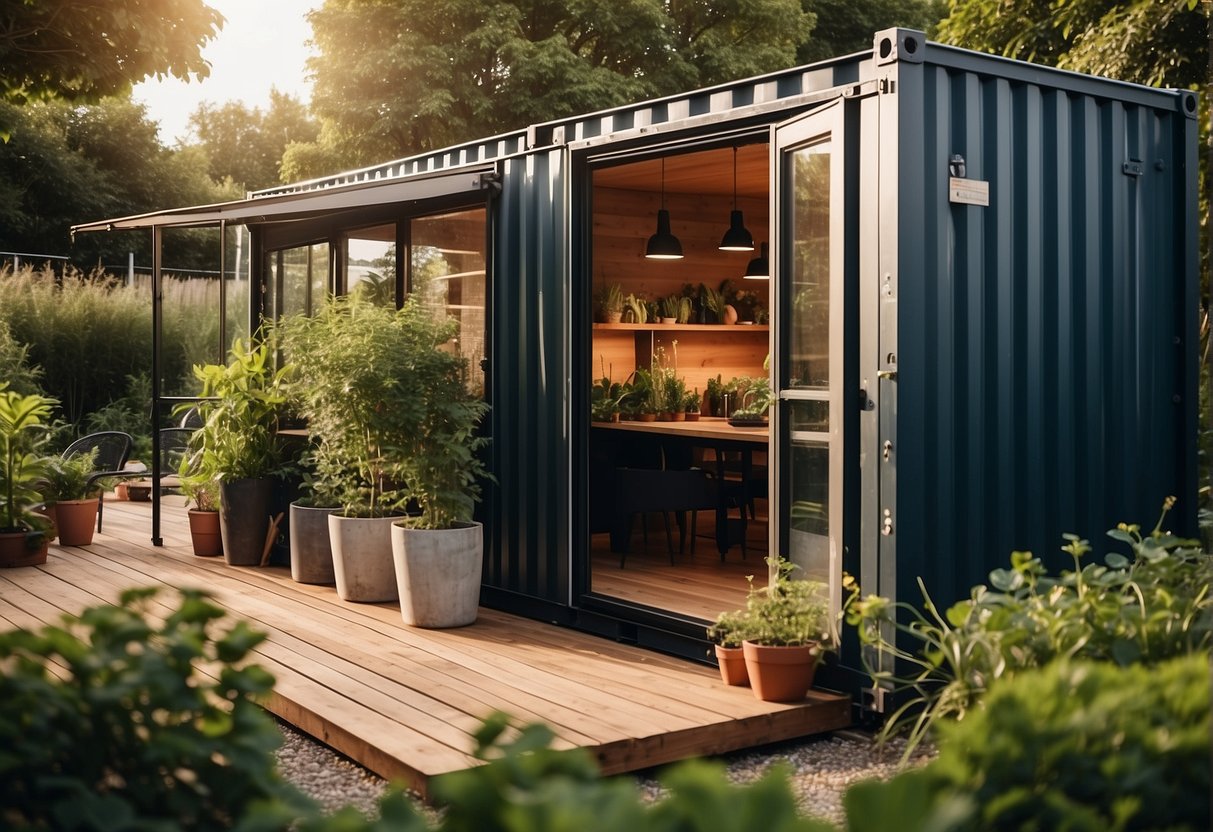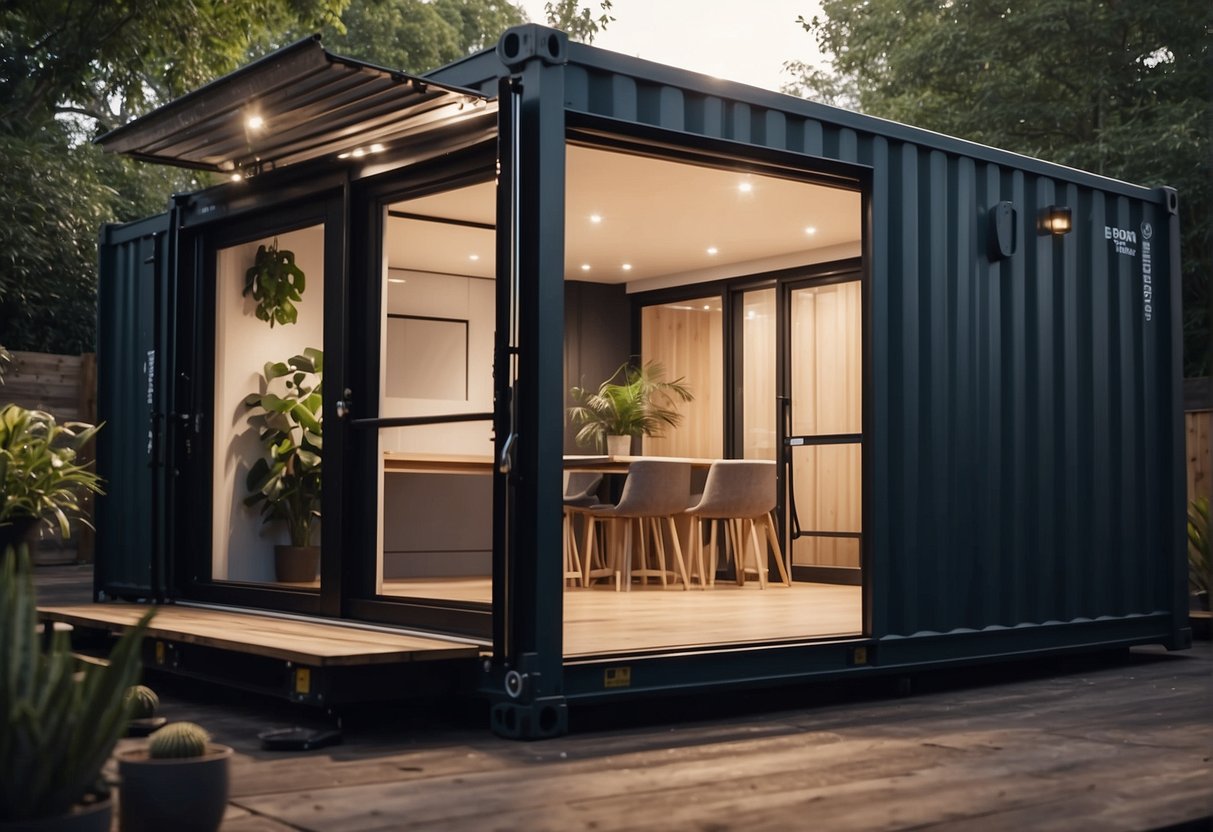Adapting to sustainable living has taken a creative turn with the rising popularity of shipping container homes. These structures, once used solely for transporting goods across oceans, have been transformed into environmentally conscious dwellings that advocate for efficient use of resources. They offer a solid framework for sustainability, given their inherent durability and the fact that they repurpose otherwise underutilized steel containers.

Converting shipping containers into habitable spaces requires foresight into capturing their full eco-friendly potential. Effective insulation is paramount for maintaining energy efficiency, which in turn minimizes their environmental footprint. Choosing sustainable materials for interior finishes and incorporating energy-saving features like LED lighting or high-efficiency appliances further enhances their green credentials.
Shipping container homes exemplify a modular approach to building, allowing for additional energy-conserving options such as rainwater harvesting systems and solar panels. This adaptability extends to their installation in diverse environments, promoting a sustainable lifestyle without compromising on modern comforts. The result is a unique synthesis of functionality, sustainability, and innovative design.
1. Understanding the Basics of Shipping Container Homes
Shipping container homes represent a blend of recycling ingenuity and modern design, offering a sustainable housing solution. They adapt easily to diverse needs, from stand-alone living spaces to complex multi-container configurations.
Historical Evolution and Modern Design
The use of shipping containers in architecture has evolved from simple, utilitarian structures to sophisticated dwellings that showcase innovation in sustainable living. Originally, these containers were strictly for cargo transport, but the 21st century has seen them repurposed into environmentally friendly homes, often celebrated for their reduced carbon footprint. The modern design of container homes can now include large windows, sliding doors, and other architectural features which promote energy efficiency and an aesthetic connection to their surroundings.
Benefits of Container Homes for Sustainable Living
Shipping containers are lauded for their role in promoting eco-friendly living. They are emblematic of sustainable construction, primarily because repurposing them as homes minimizes waste. Each container saved from scrap metal yards translates to a reduction in industrial demand for new construction materials, thus conserving resources and energy.
When converting containers into homes, builders often install insulation with high R-values to enhance energy efficiency. This practice helps maintain a stable interior temperature, lessening reliance on heating and cooling systems. Moreover, many owners integrate sustainable materials like bamboo flooring or recycled glass countertops to further decrease the dwelling’s environmental impact.
The architectural layout of container homes allows for innovative design solutions, including green roofs, solar panels, and rainwater collection systems. These features contribute to sustainability by reducing the demand for non-renewable resources and creating housing that operates with a lower ecological footprint. As they continue to gain popularity, shipping container homes exemplify how innovation and modern design are paving the way for more sustainable, eco-friendly living options.
2. Strategies for Eco-Friendly Construction
Adopting sustainable practices in construction not only protects the environment but also fosters a culture of eco-friendly living. The use of shipping containers for building is a significant step towards this goal, as it involves repurposing materials for a new function, thereby reducing waste.
Selecting Sustainable Building Materials
One starts building with the choice of materials, which is pivotal for sustainable living. Containers themselves are a form of repurposed building materials, offering a robust and durable framework. When it comes to insulation, materials such as sheep’s wool, cotton, or aerogel offer effective thermal regulation and are environmentally friendly choices. For interior finishes, one should opt for materials that are non-toxic, recycled, or sourced from sustainable forests to maintain an eco-friendly stance.
Prioritizing Durable Design for Longevity
A building’s longevity lies in its design. Shipping containers inherently boast a structure that can withstand harsh conditions, which makes them particularly suited for long-lasting use. Incorporating a design that allows for natural light can reduce electrical needs, while a well-thought-out layout can facilitate energy efficiency. Durable, low-maintenance materials that stand the test of time are preferred, ensuring that the building not only serves its purpose but does so with minimal environmental impact.
3. Optimizing Shipping Container Homes for Energy Efficiency
Optimizing energy efficiency in shipping container homes is crucial for sustainability and cost savings. Specific emphasis on insulation, energy sourcing, and smart technology can significantly enhance the thermal performance and energy use of these unique living spaces.
Innovative Insulation Techniques
To mitigate heat transfer and maintain a consistent indoor temperature, one must prioritize high-quality insulation materials in a shipping container home. Spray foam insulation is particularly effective, as it conforms to the corrugated steel walls, providing an airtight seal. Additionally, materials with high R-values—indicating strong thermal performance—like rigid foam or panel insulation, are essential for minimizing energy loss.
Harnessing Renewable Energy
Incorporating solar panels is a key strategy for utilizing renewable energy sources. Shipping container homes have the unique advantage of often having flat roofs, which are ideal for solar panel installation. One may achieve significant energy savings by generating one’s own solar power, reducing dependence on traditional energy grids, and leveraging clean energy.
Smart Systems and Eco-friendly Appliances
The integration of smart systems, such as programmable thermostats or energy recovery ventilators, further optimizes energy efficiency. These compact ventilators ensure a steady flow of air, balancing ventilation with minimum heat loss. Choosing appliances with high energy star ratings reduces energy use and drives energy conservation. Employing LED lighting and water-saving fixtures contributes to overall energy savings and sustainable living.
4. Site-Specific Considerations for Container Homes

Creating a shipping container home requires careful planning to ensure it is both sustainable and harmonious with its surroundings. Before delving into the construction phase, it’s essential to evaluate the foundation requirements and the local environment which will host the new abode.
Preparing the Foundation and Addressing Site Conditions
Site preparation is critical in establishing a secure foundation for a shipping container home. The foundation type chosen must be compatible with the soil’s ability to retain water, as poor conditions can lead to instability and even flooding. Comprehensive soil testing should be performed to assess these properties. When planning the layout of the shipping container home, consider the flexibility of the design to adapt to the harsh conditions that may be unique to your location.
- Start by choosing the appropriate foundation type that can withstand the area’s environmental stresses.
- Implement safeguards, such as grading the site away from the foundation, to manage rainwater effectively.
Integrating Containers with Local Environment
A sustainable container home should blend with the local environment and comply with building codes. Utilize the shipping container’s structure to harmonize with local aesthetics while being mindful of the eco-friendly components:
- Position the container to maximize natural light, promoting energy efficiency.
- Opt for insulation choices that balance thermal efficiency with sustainability, reducing the home’s carbon footprint.
Container homes offer flexibility in incorporating local elements such as a garden or rainwater collection systems. These features not only reduce the environmental impact but can also provide fresh vegetables and other produce directly from your property.
- Design the exterior spaces to support local flora and fauna, enhancing the home’s connection with nature.
- Integrate rainwater collection systems to sustain your garden and reduce water usage.
5. Practical Tips for Sustainable Living

The rise of shipping container homes has heralded a new era of sustainability and practicality in eco-friendly living. This section distills key insights into achieving an environmentally conscious lifestyle through innovative repurposing and sustainable practices within the unique confines of a converted shipping container.
Creating a Sustainable Off-Grid Lifestyle
Shipping container homes offer unparalleled versatility for those interested in an off-grid lifestyle. Integrating solar panels and rainwater harvesting systems can make a container home largely self-sufficient. Insulation is crucial; choosing materials like sheep’s wool or cotton batts can retain heat in winter and keep the interior cool in summer, enhancing energy efficiency without sacrificing comfort.
Eco-Friendly Interior and Exterior Finishing Choices
For interior finishes, look to repurposed or sustainable materials to maintain an eco-friendly footprint. Bamboo flooring is not only attractive but also durable and grown in a way that’s kinder to the environment. On the exterior, green roofs can be implemented, not only for their unique aesthetic but also for their insulation properties and ability to support a garden, further enhancing the eco-friendliness of the home.
Adopting a Community-Focused Approach
Joining or creating a container home community reinforces sustainable living through shared resources and collective eco-friendly practices. Composting is a community-enriching practice—sharing a central compost pile can turn waste like tea bags, vegetable peels, and garden clippings into nutrient-rich soil. A community ethos promotes practical and moral support for living more sustainably.
6. Leveraging the Modular Nature for Adaptive Design

The modular nature of shipping containers offers unparalleled versatility in designing eco-friendly living spaces. Architects and builders can exploit this to create adaptive designs that are both size-conscious and sustainable.
Flexibility in Spatial Layout and Expansion
One of the principal advantages of using shipping containers is their modular nature, allowing for a high degree of flexibility in spatial layout. This modularity means that the layout is not just easily changeable but it can also facilitate expansion. For instance:
- Multiple containers can be stacked or aligned in various configurations.
- They can be cut and restructured to create different sizes and shapes of rooms.
- Designing for future expansion is simplified as new modules can be added with relative ease.
In creating an adaptive design, choosing sustainable materials for modifications is critical. Insulation is an area where eco-friendliness can greatly be enhanced. One can opt for insulation made from recycled materials, significantly minimizing the ecological footprint. Additionally, incorporating energy-efficient solutions like solar panels or green roofs can further increase the sustainability of shipping container homes.
When planning for adaptability, the layout should be designed to allow for natural light, reducing reliance on artificial lighting and thereby improving overall energy efficiency. Strategically placed skylights, windows, and glass doors can maximize daylight while preserving privacy.
Overall, the architect must consider not just the current needs but also forecast future changes, ensuring that the modular nature of the container can be fully leveraged to adapt to evolving living requirements while maintaining a commitment to sustainability.
7. Understanding Costs and Budgeting
When considering the creation of a shipping container home, it is paramount to understand the financial implications and how to manage the budget effectively. This entails evaluating the long-term cost-effectiveness and performing diligent sourcing and comparison shopping for containers.
Evaluating Long-Term Cost-Effectiveness
Building with shipping containers can be a cost-effective solution for sustainable living. However, one must consider the long-term value as much as the initial costs. For instance, investing in quality insulation can lead to significant energy efficiency, reducing monthly utility bills and delivering savings over time. Choosing sustainable building materials not only supports the environment but also can be more durable and require less maintenance.
Sourcing and Comparison Shopping for Containers
The price of a shipping container can vary based on its condition, size, and the vendor’s location. Prospective builders should shop around and compare prices from different suppliers. Pre-owned containers can offer substantial affordability, but one should inspect them rigorously to ensure they are structurally sound and free from contaminants. Budget-conscious shoppers might benefit from purchasing containers during times of low demand or looking for suppliers who offer wholesale discounts for bulk purchases.
8. Navigating Regulatory and Safety Standards

Mastering sustainable living with shipping containers requires a good understanding of regulatory and safety standards. One must ensure compliance with local building codes and obtain the necessary permits, while also focusing on maintaining the structural integrity through any modifications.
Compliance with Building Codes and Permits
Successfully incorporating shipping containers into sustainable living projects hinges on adherence to relevant building codes. Each jurisdiction has its own set of rules governing construction, and it’s essential to secure the right permits before proceeding. This is not just a formality; it’s about ensuring safety, durability, and legality.
- Check Local Regulations: Research local building codes to understand requirements for electrical, plumbing, and structural systems.
- Permit Acquisition: Apply for the necessary permits, which might include building, electrical, and plumbing permits, with costs typically ranging from $50 to $2,000 or more.
For those considering converting a container into a living space, consulting with an engineer or architect who specializes in sustainability can aid in navigating these standards. When planning for utilities, one must consider the environmental impact; opting for eco-friendly insulation and energy-efficient systems can greatly reduce a container home’s carbon footprint.
Ensuring Structural Integrity Through Modifications
Any modifications made to a shipping container must not compromise its structural integrity. Shipping containers are engineered to be stacked and withstand harsh conditions; however, cutting for windows, doors, or attaching additions requires careful planning.
- Professional Assessment: Have the structure assessed by a professional to determine what modifications can be safely made without affecting durability.
- Sustainable Materials: Choose sustainable materials for modifications that align with green living principles. This includes high-quality insulation to improve energy efficiency.
Remember, the key to maintaining a container’s integrity during modifications is to reinforce any areas that have been altered. This ensures the safety and longevity of your sustainable living space.
9. Enhancing Eco-Friendliness Through Innovation

The quest for eco-friendly living is advanced through innovative approaches in sustainability, particularly in the realm of shipping container homes. These habitats champion energy efficiency and renewable energy sources, reflecting a conscientious commitment to the environment.
Incorporating Cutting-Edge Sustainable Technology
Advancements in sustainable technology are critical for transforming shipping containers into energy-efficient homes. For instance, integrating solar panels is a direct method of harnessing renewable energy sources, significantly reducing reliance on fossil fuels. Additionally, smart insulation choices—such as spray foam or panels made from recycled materials—not only maintain internal temperatures but also minimize the carbon footprint.
- Heating and Cooling: Energy-efficient appliances, including ceiling fans, can be installed to reduce energy consumption.
- Lighting: Opt for LED or other low-energy lighting fixtures to enhance energy conservation.
Exploring Alternative Solutions for Waste and Water
Shipping container homes can include innovative waste solutions and sustainable water use strategies:
- Composting Toilets: An off-grid solution that reduces water usage and creates usable compost as a byproduct.
- Rainwater Collection Systems: These systems conserve water and reduce stormwater runoff. They can be designed to be an integral part of a container home’s aesthetic and functionality.
By incorporating such systems, they not only provide significant environmental benefits but also promote a sustainable cycle of use and replenishment.
10. Evaluating the Impact and Future of Container Living

The transformation of shipping containers into homes is not just a design trend; it’s a powerful move towards sustainable living. However, it requires a thorough understanding of both its environmental impact and its role in the landscape of modern housing.
Assessing the Environmental Benefits and Challenges
Shipping containers repurposed as homes represent a form of upcycling with significant environmental benefits. Their conversion into living spaces reduces waste by giving containers that would otherwise languish, a new lease on life. This process is central to reducing the carbon footprint associated with new construction, as the manufacture of building materials is a significant source of greenhouse gas emissions. An assessment of the life cycle of container homes showcases their potential in minimizing energy demand and global warming potential.
However, converting a container into a habitable space does come with challenges. Insulation is paramount for creating a comfortable interior climate while maintaining energy efficiency. Materials such as cotton batt insulation or spray foam can offer eco-friendly options that lower energy needs. Moreover, challenges like mitigating heat transfer through the metal walls require innovative solutions, such as green roofs or external cladding to improve thermal performance.
The Role of Shipping Containers in Modern and Tiny Homes Trends
Container homes are a prominent feature of two significant housing trends: modern living and the tiny homes movement. Their modularity offers architectural freedom, allowing them to fit seamlessly into the philosophies of minimalism and efficient use of space. They appeal to those looking for an eco-friendly lifestyle that pushes against conventional housing norms.
The tiny homes trend, aiming to minimize environmental impact and promote simpler living, finds a strong ally in shipping container conversions. They inherently support sustainable living by encouraging homeowners to downsize and consider the environmental footprint of their dwelling. This movement underscores the growing awareness around sustainable materials and energy-efficient design, which must be integral in container home construction to fully realize their eco-friendly potential.
When considering a container home, they must ensure the structure’s energy efficiency is maximized through strategic window placement for natural light and cross ventilation, high-quality insulation, and renewable energy sources, such as solar panels, if possible. Selecting sustainable materials for interior finishes further enhances the environmental credentials of these innovative homes.
